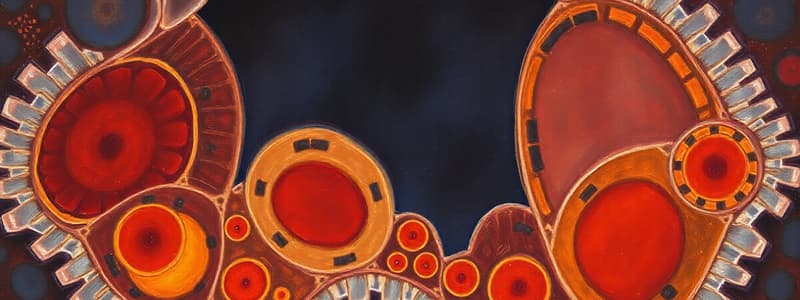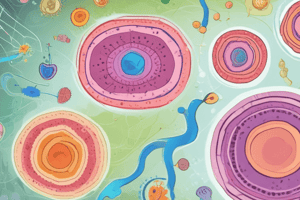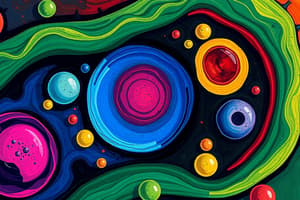Podcast
Questions and Answers
Where is most of the energy from respiration released?
Where is most of the energy from respiration released?
- In the ribosomes
- In the cytoplasm
- In the nucleus
- In the mitochondria (correct)
What is the primary function of the endoplasmic reticulum?
What is the primary function of the endoplasmic reticulum?
- Protein synthesis (correct)
- Energy production
- DNA replication
- Cell division
What chemical is the basis of inheritance in humans?
What chemical is the basis of inheritance in humans?
- Proteins
- Deoxyribonucleic acid (DNA) (correct)
- Chromosomes
- Ribonucleic acid (RNA)
What are the structures within the nucleus that contain DNA called?
What are the structures within the nucleus that contain DNA called?
Why are there many mitochondria in cells that require a lot of energy?
Why are there many mitochondria in cells that require a lot of energy?
What determines particular features in an organism?
What determines particular features in an organism?
What role do the spaces between the membranes of the endoplasmic reticulum serve?
What role do the spaces between the membranes of the endoplasmic reticulum serve?
What clue does a high number of mitochondria in certain cells provide?
What clue does a high number of mitochondria in certain cells provide?
How many organelles can be identified in cheek cells stained with dye?
How many organelles can be identified in cheek cells stained with dye?
Which of the following is a length of DNA that specifies a trait?
Which of the following is a length of DNA that specifies a trait?
What visual tool is mentioned as enabling better observation of cell structures?
What visual tool is mentioned as enabling better observation of cell structures?
What other component is specifically mentioned as being found on the endoplasmic reticulum?
What other component is specifically mentioned as being found on the endoplasmic reticulum?
Which organelle is specifically known for its role in energy production?
Which organelle is specifically known for its role in energy production?
Which cellular component carries genetic information in the form of instructions?
Which cellular component carries genetic information in the form of instructions?
What type of cells would likely contain a high density of mitochondria?
What type of cells would likely contain a high density of mitochondria?
Which organelle is primarily responsible for synthesizing proteins?
Which organelle is primarily responsible for synthesizing proteins?
What is the primary function of enzymes in cells?
What is the primary function of enzymes in cells?
What characteristic of the cell membrane allows some substances to pass through while blocking others?
What characteristic of the cell membrane allows some substances to pass through while blocking others?
What is the role of ribosomes found on the endoplasmic reticulum?
What is the role of ribosomes found on the endoplasmic reticulum?
Why is the cell membrane sometimes referred to as the cell surface membrane?
Why is the cell membrane sometimes referred to as the cell surface membrane?
What does the term 'selectively permeable' mean in the context of the cell membrane?
What does the term 'selectively permeable' mean in the context of the cell membrane?
What networks are formed by membranes throughout the cytoplasm?
What networks are formed by membranes throughout the cytoplasm?
What is the function of mitochondria in relation to the cell membrane?
What is the function of mitochondria in relation to the cell membrane?
What defines a cell's boundary from its external environment?
What defines a cell's boundary from its external environment?
What is the primary function of the nucleus in a cell?
What is the primary function of the nucleus in a cell?
Which of the following is NOT a component typically found in animal cells?
Which of the following is NOT a component typically found in animal cells?
What is the texture of cytoplasm described as?
What is the texture of cytoplasm described as?
How many chromosomes are typically found in human cells?
How many chromosomes are typically found in human cells?
What type of microscope is necessary to see detailed structures within a cell?
What type of microscope is necessary to see detailed structures within a cell?
What is the function of genes within the nucleus?
What is the function of genes within the nucleus?
Which of the following statements about organelles is true?
Which of the following statements about organelles is true?
What is the living material that makes up a cell known as?
What is the living material that makes up a cell known as?
Flashcards
Endoplasmic Reticulum
Endoplasmic Reticulum
Organelle where proteins are made and transported through the cell.
Nucleus
Nucleus
Organelle containing the cell's genetic material.
Mitochondrion
Mitochondrion
Organelle that releases energy for the cell.
Enzymes
Enzymes
Signup and view all the flashcards
Cell membrane
Cell membrane
Signup and view all the flashcards
Partially permeable membrane
Partially permeable membrane
Signup and view all the flashcards
Selectively permeable membrane
Selectively permeable membrane
Signup and view all the flashcards
Endoplasmic reticulum (ER)
Endoplasmic reticulum (ER)
Signup and view all the flashcards
Ribosomes
Ribosomes
Signup and view all the flashcards
Mitochondria
Mitochondria
Signup and view all the flashcards
Cells from cheek lining
Cells from cheek lining
Signup and view all the flashcards
Chromosomes
Chromosomes
Signup and view all the flashcards
Genes
Genes
Signup and view all the flashcards
DNA
DNA
Signup and view all the flashcards
Nucleus
Nucleus
Signup and view all the flashcards
Cell
Cell
Signup and view all the flashcards
Cytoplasm
Cytoplasm
Signup and view all the flashcards
Organelles
Organelles
Signup and view all the flashcards
Nucleus
Nucleus
Signup and view all the flashcards
Chromosomes
Chromosomes
Signup and view all the flashcards
Genes
Genes
Signup and view all the flashcards
Animal Cell
Animal Cell
Signup and view all the flashcards
Cell Membrane
Cell Membrane
Signup and view all the flashcards
Mitochondria
Mitochondria
Signup and view all the flashcards
Study Notes
Cell Structure
- Cells are the basic building blocks of living organisms, with specialized types to carry out specific functions.
- Basic features are similar across cell types.
- Cytoplasm is the living material within a cell, having a jelly-like consistency.
- Organelles are complex structures within the cytoplasm, not visible with a light microscope, but visible with an electron microscope.
- Nucleus is the largest organelle, controlling cell activities and containing chromosomes, which hold genetic material (genes).
- Human cells typically have 46 chromosomes.
- Genes control proteins (including enzymes, important for chemical reactions), that a cell can make.
- Cell membrane surrounds the cell, separating cytoplasm from the outside, and is partially permeable.
- Endoplasmic reticulum (ER) is a network of membranes in the cytoplasm; it transports proteins to where needed in the cell.
- Ribosomes are granules on the ER, where protein synthesis occurs.
- Mitochondria are organelles crucial for energy release, especially important in cells needing lots of energy.
- Cells in a tissue are often similar in structure.
Chromosomes, Genes, and DNA
- DNA is the basis of inheritance, found in chromosomes (within the nucleus) in cells.
- A section of DNA that determines a feature is called a gene.
- Genes instruct cells to produce specific proteins determining characteristics.
- Chromosomes are composed of DNA tightly coiled around proteins called histones.
- Each chromosome contains one DNA molecule.
- DNA is often depicted as a double helix, and coiled around proteins for compactness.
Studying That Suits You
Use AI to generate personalized quizzes and flashcards to suit your learning preferences.




